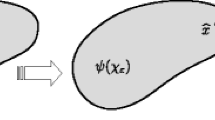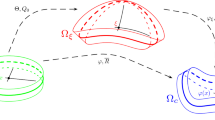Abstract
Uniqueness and symmetry of solution are investigated for topology optimization of a symmetric continuum structure subjected to symmetrically distributed loads. The structure is discretized into finite elements, and the compliance is minimized under constraint on the structural volume. The design variables are the densities of materials of elements, and intermediate densities are penalized to prevent convergence to a gray solution. A path of solution satisfying conditions for local optimality is traced using the continuation method with respect to the penalization parameter. It is shown that the rate form of the solution path can be formulated from the optimality conditions, and the uniqueness and bifurcation of the path are related to eigenvalues and eigenvectors of the Jacobian of the governing equations. This way, local uniqueness and symmetry breaking process of the solution are rigorously investigated through the bifurcation of a solution path.








Similar content being viewed by others
References
Allaire G, Jouve F, Toader AM (2002) A level set method for shape optimization. C R Acad Sci 334:1125–1130
Allaire G, Jouve F, Toader AM (2004) Structural optimization using sensitivity analysis and a level-set method. J Comput Phys 104:363–393
Allgower EL, Georg K (1993) Continuation and path following. Acta Numer 2:1–64
Belblidia F, Bulman S (2002) A hybrid topology optimization algorithm for static and vibrating shell structures. Int J Numer Methods Eng 24:835–852
Bendsøe MP (1989) Optimal shape design as a material distribution problem. Struct Optim 1:193–202
Bendsøe MP, Kikuchi N (1988) Generating optimal topologies in structural design using a homogenization method. Comput Methods Appl Mech Eng 71:197–224
Bendsøe MP, Sigmund O (2003) Topology optimization: theory, methods and applications. Springer, Berlin
Bruns TE (2005) A reevaluation of the SIMP method with filtering and an alternative formulation for solid–void topology optimization. Struct Multidisc Optim 30:428–436
Bruns TE (2007) Topology optimization by penalty (TOP) method. Comput Methods Appl Mech Eng 196:4430–4443
Choi KK, Kim N-H (2004) Structural sensitivity analysis and optimization, vol 1. Linear systems. Springer, New York
Fiacco AV (1983) Introduction to sensitivity and stability analysis in nonlinear programming. Academic
Gal T (1979) Postoptimal analyses, parametric programming, and related topics. Mc-Graw Hill
Gill PE, Murray W, Saunders MA (2002) SNOPT: an SQP algorithm for large-scale constrained optimization. SIAM J Optim 12:979–1006
Golubitsky M, Schaegger D (1979) A theory for imperfect bifurcation via singularity theory. Commun Pure Appl Math 32:21–98
Ikeda K, Murota K (2010) Imperfect bifurcation in structures and materials—engineering use of group-theoretic bifurcation theory, 2nd edn. Applied mathematical sciences, vol 149. Springer, New York
Jog CS, Haber RB (1996) Stability of finite element models for distributed-parameter optimization and topology design. Comput Methods Appl Mech Eng 130:203–226
Kanno Y, Ohsaki M, Murota K, Katoh N (2001) Group symmetry in interior-point methods for semi-definite program. Optim Eng 2:293–320
Kettle SFA (2007) Symmetry and structure: readable group theory for chemists. Wiley, Chichester
Kočvara M, Outrata JV (2006) Effective reformulation of the truss topology design problem. Optim Eng 7:201–219
Martínez JM (2005) A note on the theoretical convergence properties of the SIMP method. Struct Multidisc Optim 29:319–323
Maute K, Ramm E (1997) Adaptive topology optimization of shell structures. AIAA J 35:1767–1773
Mittelmann HD, Roose D (eds) (1990) Continuation techniques and bifurcation problems. Birkhäuser, Basel
Moses E, Fuchs MB, Ryvkin M (2003) Topology design of modular structures under arbitrary loading. Struct Multidisc Optim 24:407–417
Nakamura T, Ohsaki M (1988) Sequential optimal truss generator for frequency ranges. Comput Methods Appl Mech Eng 67(2):189–209
Ohsaki M (2006) Local and global searches of approximate optimal designs of regular frames. Int J Numer Methods Eng 67:132–147
Ohsaki M, Nakamura T (1996) Minimum constraint perturbation method for topology optimization of systems. Eng Opt 26:171–186
Ohsaki M, Ikeda K (2007) Stability and optimization of structures—generalized sensitivity analysis. Mechanical engineering series. Springer, New York
Petersson J (1999a) A finite element analysis of optimal variable thickness sheets. SIAM J Numer Anal 36(6):1759–1778
Petersson J (1999b) Some convergence results of perimeter-controlled topology optimization. Comput Methods Appl Mech Eng 171:121–140
Petersson J, Sigmund O (1998) Slope constrained topology optimization. Int J Numer Methods Eng 41:1417–1434
Rietz A (2001) Sufficiency of a finite exponent in SIMP (power law) methods. Struct Multidisc Optim 21:159–163
Rietz A (2007) Modified conditions for minimum of compliance. Comput Methods Appl Mech Eng 196:4413–4418
Rozvany GIN (2009) A critical review of established methods of structural topology optimization. Struct Multidisc Optim 37:217–237
Rozvany GIN (2011) On symmetry and nonuniqueness in exact topology optimization. Struct Multidisc Optim. Published online. doi:10.1007/s00158-010-0564-0
Rozvany GIN, Zhou M, Birker T (1992) Generalized shape optimization without homogenization. Struct Optim 4:250–252
Rozvany GIN, Zhou M, Sigmund O (1994) Topology optimization. In: Adeli H (ed) Advances in design optimization, Chapter 10. Chapman and Hall, London
Sethian JA, Wiegmann A (2000) Structural boundary design via level-set and immersed interface methods. J Comput Phys 163(2):489–528
Stolpe M (2010) On some fundamental properties of structural topology optimization problems. Struct Multidisc Optim 41:661–670
Stolpe M, Svanberg K (2001) On the trajectories of the epsilon-relaxation approach for stress-constrained truss topology optimization. Struct Multidisc Optim 21:140–151
Suzuki K, Kikuchi N (1991) A homogenization method for shape and topology optimization. Comput Methods Appl Mech Eng 93:291–318
Wang MY, Wang XM, Guo DM (2003) A level set method for structural topology optimization. Comput Methods Appl Mech Eng 192:227–246
Watson LT, Haftka RT (1989) Modern homotopy methods in optimization. Comput Methods Appl Mech Eng 74(3):289–305
Yamada T, Nishiwaki S, Izui K, Yoshimura M, Takezawa A (2009) A new level set based topology optimization method using a fictitious interface energy model based on phase field method concepts. In: Proc. 8th world congress of structural and multidisciplinary optimization (WCSMO8), paper no. 1136. Lisbon
Yamasaki S, Nomura T, Kawamoto A, Sato K, Izui K, Nishiwaki S (2010) A level set based topology optimization method using the discretized signed distance function as the design variables. Struct Multidisc Optim 41:685–698
Author information
Authors and Affiliations
Corresponding author
Additional information
A part of this paper was presented at the 8th World Congress of Structural and Multidisciplinary Optimization (WCSMO8).
Rights and permissions
About this article
Cite this article
Watada, R., Ohsaki, M. & Kanno, Y. Non-uniqueness and symmetry of optimal topology of a shell for minimum compliance. Struct Multidisc Optim 43, 459–471 (2011). https://doi.org/10.1007/s00158-010-0587-6
Received:
Revised:
Accepted:
Published:
Issue Date:
DOI: https://doi.org/10.1007/s00158-010-0587-6




